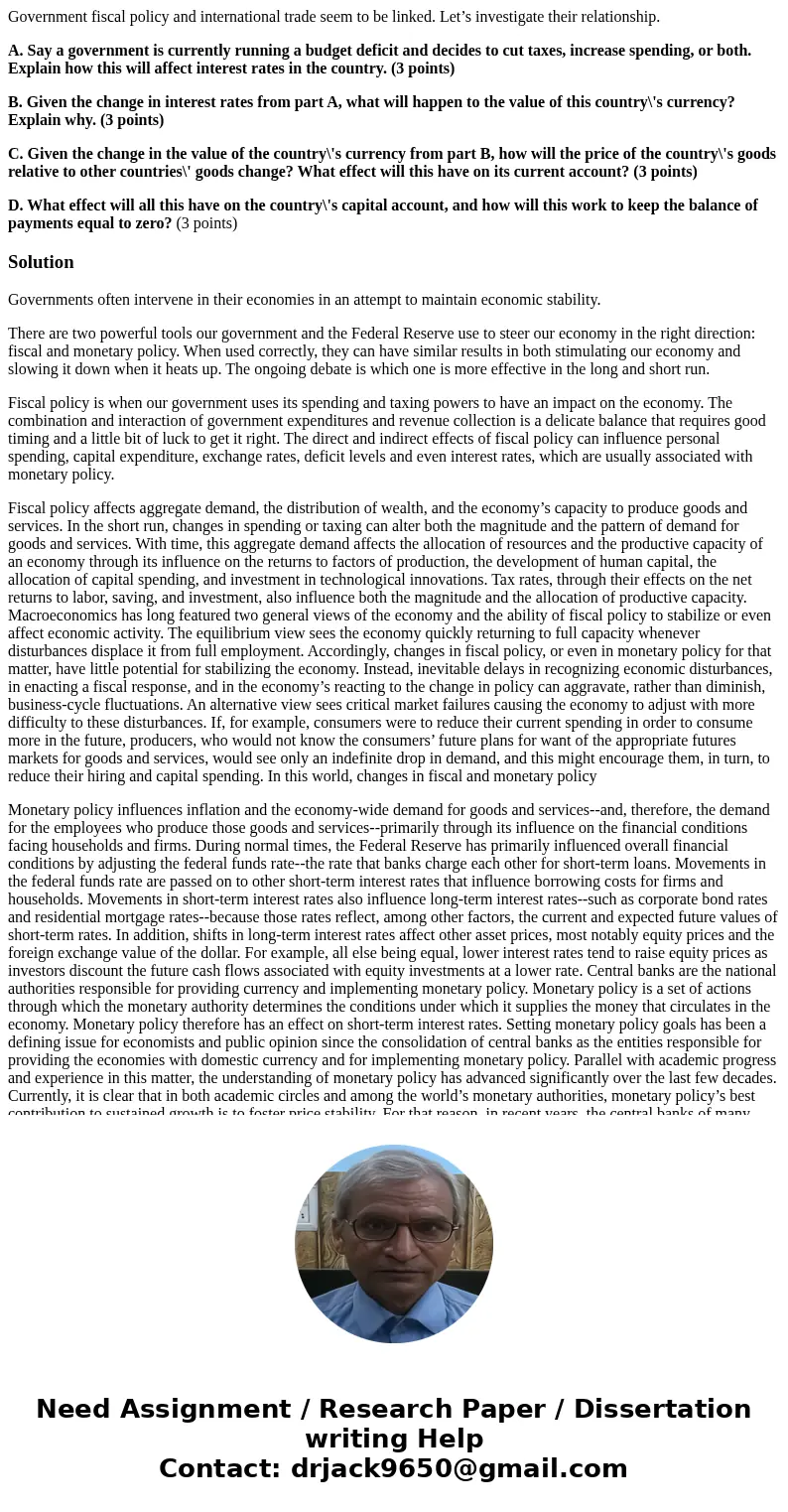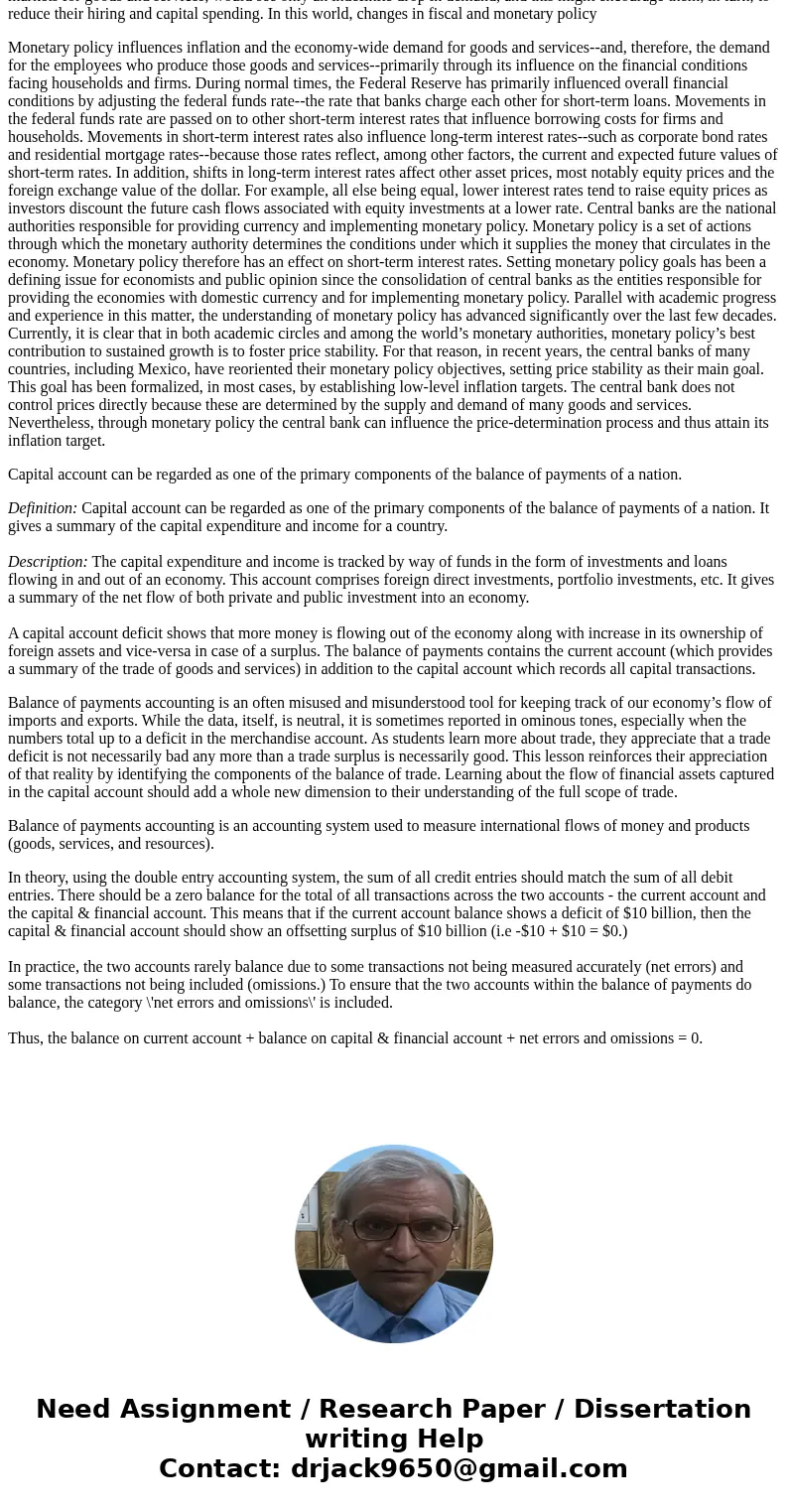Government fiscal policy and international trade seem to be
Government fiscal policy and international trade seem to be linked. Let’s investigate their relationship.
A. Say a government is currently running a budget deficit and decides to cut taxes, increase spending, or both. Explain how this will affect interest rates in the country. (3 points)
B. Given the change in interest rates from part A, what will happen to the value of this country\'s currency? Explain why. (3 points)
C. Given the change in the value of the country\'s currency from part B, how will the price of the country\'s goods relative to other countries\' goods change? What effect will this have on its current account? (3 points)
D. What effect will all this have on the country\'s capital account, and how will this work to keep the balance of payments equal to zero? (3 points)
Solution
Governments often intervene in their economies in an attempt to maintain economic stability.
There are two powerful tools our government and the Federal Reserve use to steer our economy in the right direction: fiscal and monetary policy. When used correctly, they can have similar results in both stimulating our economy and slowing it down when it heats up. The ongoing debate is which one is more effective in the long and short run.
Fiscal policy is when our government uses its spending and taxing powers to have an impact on the economy. The combination and interaction of government expenditures and revenue collection is a delicate balance that requires good timing and a little bit of luck to get it right. The direct and indirect effects of fiscal policy can influence personal spending, capital expenditure, exchange rates, deficit levels and even interest rates, which are usually associated with monetary policy.
Fiscal policy affects aggregate demand, the distribution of wealth, and the economy’s capacity to produce goods and services. In the short run, changes in spending or taxing can alter both the magnitude and the pattern of demand for goods and services. With time, this aggregate demand affects the allocation of resources and the productive capacity of an economy through its influence on the returns to factors of production, the development of human capital, the allocation of capital spending, and investment in technological innovations. Tax rates, through their effects on the net returns to labor, saving, and investment, also influence both the magnitude and the allocation of productive capacity. Macroeconomics has long featured two general views of the economy and the ability of fiscal policy to stabilize or even affect economic activity. The equilibrium view sees the economy quickly returning to full capacity whenever disturbances displace it from full employment. Accordingly, changes in fiscal policy, or even in monetary policy for that matter, have little potential for stabilizing the economy. Instead, inevitable delays in recognizing economic disturbances, in enacting a fiscal response, and in the economy’s reacting to the change in policy can aggravate, rather than diminish, business-cycle fluctuations. An alternative view sees critical market failures causing the economy to adjust with more difficulty to these disturbances. If, for example, consumers were to reduce their current spending in order to consume more in the future, producers, who would not know the consumers’ future plans for want of the appropriate futures markets for goods and services, would see only an indefinite drop in demand, and this might encourage them, in turn, to reduce their hiring and capital spending. In this world, changes in fiscal and monetary policy
Monetary policy influences inflation and the economy-wide demand for goods and services--and, therefore, the demand for the employees who produce those goods and services--primarily through its influence on the financial conditions facing households and firms. During normal times, the Federal Reserve has primarily influenced overall financial conditions by adjusting the federal funds rate--the rate that banks charge each other for short-term loans. Movements in the federal funds rate are passed on to other short-term interest rates that influence borrowing costs for firms and households. Movements in short-term interest rates also influence long-term interest rates--such as corporate bond rates and residential mortgage rates--because those rates reflect, among other factors, the current and expected future values of short-term rates. In addition, shifts in long-term interest rates affect other asset prices, most notably equity prices and the foreign exchange value of the dollar. For example, all else being equal, lower interest rates tend to raise equity prices as investors discount the future cash flows associated with equity investments at a lower rate. Central banks are the national authorities responsible for providing currency and implementing monetary policy. Monetary policy is a set of actions through which the monetary authority determines the conditions under which it supplies the money that circulates in the economy. Monetary policy therefore has an effect on short-term interest rates. Setting monetary policy goals has been a defining issue for economists and public opinion since the consolidation of central banks as the entities responsible for providing the economies with domestic currency and for implementing monetary policy. Parallel with academic progress and experience in this matter, the understanding of monetary policy has advanced significantly over the last few decades. Currently, it is clear that in both academic circles and among the world’s monetary authorities, monetary policy’s best contribution to sustained growth is to foster price stability. For that reason, in recent years, the central banks of many countries, including Mexico, have reoriented their monetary policy objectives, setting price stability as their main goal. This goal has been formalized, in most cases, by establishing low-level inflation targets. The central bank does not control prices directly because these are determined by the supply and demand of many goods and services. Nevertheless, through monetary policy the central bank can influence the price-determination process and thus attain its inflation target.
Capital account can be regarded as one of the primary components of the balance of payments of a nation.
Definition: Capital account can be regarded as one of the primary components of the balance of payments of a nation. It gives a summary of the capital expenditure and income for a country.
Description: The capital expenditure and income is tracked by way of funds in the form of investments and loans flowing in and out of an economy. This account comprises foreign direct investments, portfolio investments, etc. It gives a summary of the net flow of both private and public investment into an economy.
A capital account deficit shows that more money is flowing out of the economy along with increase in its ownership of foreign assets and vice-versa in case of a surplus. The balance of payments contains the current account (which provides a summary of the trade of goods and services) in addition to the capital account which records all capital transactions.
Balance of payments accounting is an often misused and misunderstood tool for keeping track of our economy’s flow of imports and exports. While the data, itself, is neutral, it is sometimes reported in ominous tones, especially when the numbers total up to a deficit in the merchandise account. As students learn more about trade, they appreciate that a trade deficit is not necessarily bad any more than a trade surplus is necessarily good. This lesson reinforces their appreciation of that reality by identifying the components of the balance of trade. Learning about the flow of financial assets captured in the capital account should add a whole new dimension to their understanding of the full scope of trade.
Balance of payments accounting is an accounting system used to measure international flows of money and products (goods, services, and resources).
In theory, using the double entry accounting system, the sum of all credit entries should match the sum of all debit entries. There should be a zero balance for the total of all transactions across the two accounts - the current account and the capital & financial account. This means that if the current account balance shows a deficit of $10 billion, then the capital & financial account should show an offsetting surplus of $10 billion (i.e -$10 + $10 = $0.)
In practice, the two accounts rarely balance due to some transactions not being measured accurately (net errors) and some transactions not being included (omissions.) To ensure that the two accounts within the balance of payments do balance, the category \'net errors and omissions\' is included.
Thus, the balance on current account + balance on capital & financial account + net errors and omissions = 0.


 Homework Sourse
Homework Sourse